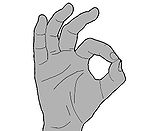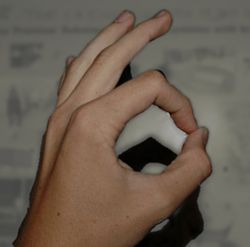- A-ok
-
An A-OK /ˌeɪ.oʊˈkeɪ/ is both a saying, derived from okay, and a hand-gesture done by connecting the thumb and forefinger in to a circle (the O), and holding the other fingers straight or relaxed in the air.
Unicode symbol U+1F44C () represents this gesture.
Contents
Etymology
US Air Force Lt. Col. John "Shorty" Powers popularized the expression "A-OK" while NASA's public affairs officer for Project Mercury, attributing it to astronaut Alan Shepard during his Freedom 7 flight.[1][2] In his book The Right Stuff, however, author Tom Wolfe wrote that Powers had borrowed it from NASA engineers who used it during radio transmission tests because the sharper sound of A cut through the static better than O.[3] Apparently, the first documented use "A-OK" is contained within a memo from Tecwyn Roberts, Flight Dynamics Officer, to Flight Director (entitled "Report on Test 3805", dated Feb. 2, 1961) in penciled notes on the countdown of MR-2, dated Jan. 31, 1961.[4]
Multiple meanings
While the gesture is positive in some countries, in certain parts of middle and southern Europe (although not in Spain or Portugal) the gesture is considered offensive, as in you are a zero or you are nothing. In some Mediterranean countries, as well as in Brazil, it represents vulgar expressions: either an insult (you are an asshole), or the slang for anus itself. In Brazil it can either mean okay or up yours! if the palm of the hand is faced to the performer, especially the performer's torso. By the same symbolism, it stands for marica (faggot) in several South American countries.
The 'A-OK' gesture is also associated with the circle game, in which players attempt to trick other players into looking at the 'A-OK' below their waist.[5]
Positive connotation
Vitarka mudra, Tarim Basin, 9th century
In Australia and Portugal, it can either mean okay or zero.
In Finland, it is used to celebrate ending of the national service.[citation needed] During their final day in the Finnish Defence Forces, conscripts use it denote they have zero days left in their service, and that they will receive an honorable discharge during the course of that day. It is also used to tease and taunt other conscripts that still have various numbers of days left, and are stuck while their comrades are allowed to leave. Colloquially, it is referred to as the TJ0 or 'Tänään jäljellä 0 aamua', which translates to 'Zero mornings left today'. The official TJ counter can be viewed on the Finnish Defence Forces website.[6]
 Diving signal for "I'm OK" or "Are you OK?"
Diving signal for "I'm OK" or "Are you OK?"
In underwater diving, it widely means both Are you okay?, and its response Yes, I'm OK, or just I'm OK. It can be confusing for beginners, because using the thumbs up gesture rather than the A-OK gesture signals that the person making that gesture wants to ascend (to the surface).
In Macedonia, in addition to meaning OK, it is also a nationalistic United Macedonia salute.[citation needed] The two fingers in a circle symbolize the letter O, which is the first letter of the Macedonian word Обединета (Obedineta) meaning united, referring to a United Macedonia. The other three fingers symbolize the three regions of Macedonia: Vardar Macedonia, Aegean Macedonia, and Pirin Macedonia. The five fingers as a whole resemble the Vergina Sun, which was Macedonia's flag from 1992 to 1995.
In basketball, players throw up this sign to show they just made a three pointer.
A similar gesture, the Vitarka mudra ("mudra of discussion") is the gesture of discussion and transmission of Buddhist teaching.[7]
Negative connotation
This gesture resembles the American Sign Language sign for the number 9, and when made with the thumb and forefinger parallel to the ground, asshole.[citation needed]
In Turkey and Venezuela, it is a very offensive gesture, regarded as a reference to homosexuality, and reflecting a wider than usual (due to anal sex) anus of a homosexual man. In Peru too, but it is upside-down with the middle, ring and little fingers pointing down.[citation needed]. In Brazil it is also an offensive gesture, equivalent to showing the middle finger.
In most continental European countries, when the sign is placed over the nose, with the nose protruding through the O made by the thumb and forefinger, it means drunk.[citation needed]
In Japan, it also means zero or money.[citation needed]
In Chinese number gestures, it is the hand gesture for number three.
In Mexico, if the hand gesture is slightly tilted it may mean "culo" (anus), used to refer to a coward.[weasel words]
In the Arab world, this sign is used as a threatening gesture, as in saying: "You'll see!".[citation needed]
References
- ^ "Calm Voice from Space". Time (Time Inc.). 1962-03-02. http://www.time.com/time/printout/0,8816,939891,00.html. Retrieved April 3, 2011.
- ^ Strauss, Mark (April 15, 2011). "Ten Enduring Myths About the U.S. Space Program". Smithsonian (magazine). http://www.smithsonianmag.com/science-nature/Ten-Enduring-Myths-About-the-US-Space-Program.html?c=y&page=1. Retrieved 8 September 2011.
- ^ Wolfe, Tom The Right Stuff, p. 215
- ^ "Tecwyn Roberts: A-OK." llanddaniel.co.uk. Retrieved: 5 May 2011.
- ^ The Original Website of the Circle Game
- ^ Försvarsmakten, the Finnish Defence Forces Varusmies (Finnish)
- ^ Gertrud Hirschi (2000). Mudras: yoga in your hands (illustrated ed.). Weiser Books. p. 140. ISBN 9781578631391.
Gestures Friendly gestures Air kiss · A-ok · Cheek kissing · Dap greeting · Elbow bump · Eskimo kissing · Fist bump · Hat tip · High five · Hongi · ILY sign · Namaste · Sign of the horns · Shaka · Thumbs signal · WaiFormal gestures Salutes Bellamy salute · Nazi salute · Raised fist · Roman salute · Scout sign and salute · Three-finger salute · Two-finger salute · Vulcan salute · Zogist saluteCelebratory gestures Finger counting Obscene gestures Head motions Other gestures Air quotes · Anasyrma · Crossed fingers · Facepalm · Finger gun · Gang signal · Hand-rubbing · Jazz hands · Kuji-in · Laban sign · Loser · Mudra · Pollice verso · Puppy face · Shrug · Sign of the Cross · Varadamudra · V signRelated Categories:- Gestures
Wikimedia Foundation. 2010.


